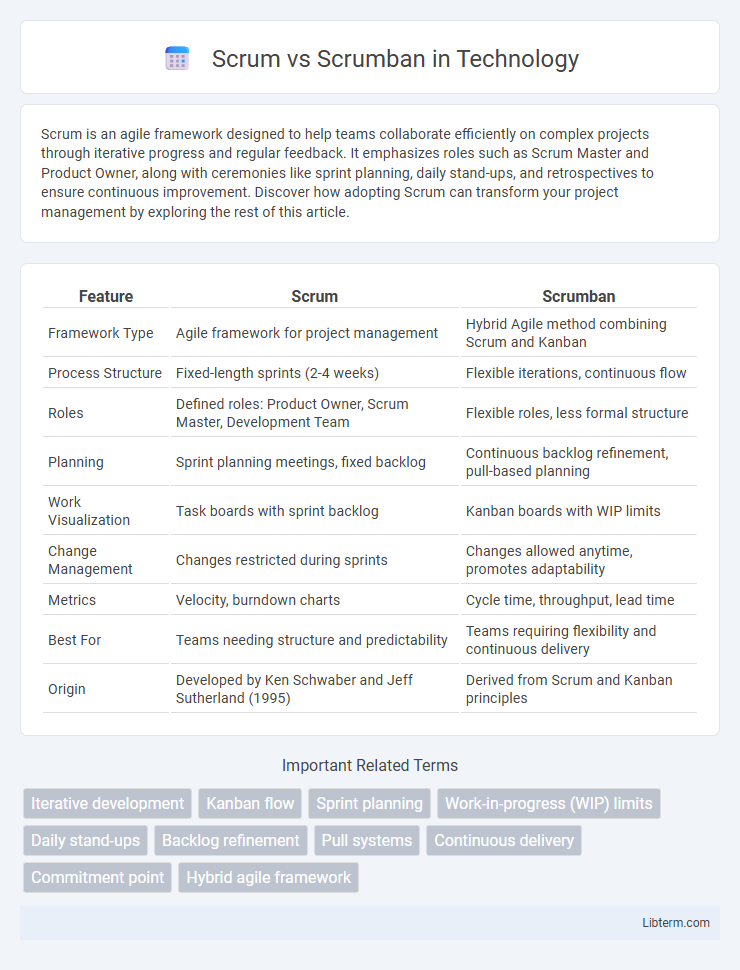Scrum is an agile framework designed to help teams collaborate efficiently on complex projects through iterative progress and regular feedback. It emphasizes roles such as Scrum Master and Product Owner, along with ceremonies like sprint planning, daily stand-ups, and retrospectives to ensure continuous improvement. Discover how adopting Scrum can transform your project management by exploring the rest of this article.
Table of Comparison
| Feature | Scrum | Scrumban |
|---|---|---|
| Framework Type | Agile framework for project management | Hybrid Agile method combining Scrum and Kanban |
| Process Structure | Fixed-length sprints (2-4 weeks) | Flexible iterations, continuous flow |
| Roles | Defined roles: Product Owner, Scrum Master, Development Team | Flexible roles, less formal structure |
| Planning | Sprint planning meetings, fixed backlog | Continuous backlog refinement, pull-based planning |
| Work Visualization | Task boards with sprint backlog | Kanban boards with WIP limits |
| Change Management | Changes restricted during sprints | Changes allowed anytime, promotes adaptability |
| Metrics | Velocity, burndown charts | Cycle time, throughput, lead time |
| Best For | Teams needing structure and predictability | Teams requiring flexibility and continuous delivery |
| Origin | Developed by Ken Schwaber and Jeff Sutherland (1995) | Derived from Scrum and Kanban principles |
Introduction to Scrum and Scrumban
Scrum is a structured agile framework emphasizing fixed-length sprints, defined roles like Product Owner and Scrum Master, and ceremonies such as daily stand-ups, sprint planning, and retrospectives to enhance team collaboration and product delivery. Scrumban combines Scrum's iterative approach with Kanban's continuous workflow visualization and flexibility, enabling teams to adapt quickly to changing priorities while maintaining organized task management. This hybrid methodology suits projects requiring both the discipline of Scrum and the adaptability of Kanban, improving efficiency and responsiveness.
Core Principles of Scrum
Scrum's core principles emphasize iterative progress through fixed-length sprints, clear roles including Product Owner, Scrum Master, and Development Team, and regular ceremonies such as Sprint Planning, Daily Standups, Sprint Review, and Retrospective to ensure transparency and continuous improvement. Scrum promotes empirical process control based on transparency, inspection, and adaptation, enabling teams to respond effectively to change and deliver value incrementally. Unlike Scrumban, which blends Scrum and Kanban practices for more flexible workflow management, Scrum strictly enforces time-boxed iterations and defined roles to drive discipline and accountability in agile project delivery.
Key Features of Scrumban
Scrumban combines Scrum's structured sprint planning and roles with Kanban's visual workflow management and continuous delivery, enabling flexibility in task prioritization and work-in-progress limits. Key features of Scrumban include pull-based task selection, use of Kanban boards for real-time work visualization, and absence of fixed-length sprints, allowing teams to adapt quickly to changing requirements. This hybrid approach optimizes efficiency by minimizing bottlenecks and enhancing collaboration through iterative review and planning cycles.
Workflow Differences: Scrum vs Scrumban
Scrum follows a structured workflow with fixed-length sprints, specific roles, and predefined ceremonies like sprint planning, daily stand-ups, sprint reviews, and retrospectives, ensuring predictable delivery cycles. Scrumban merges Scrum's sprint-based approach with Kanban's continuous flow, allowing teams to pull tasks based on capacity without fixed iterations, which increases flexibility in prioritization and workload management. Unlike Scrum's prescriptive framework, Scrumban emphasizes a visual workflow board with WIP (Work In Progress) limits to optimize task flow and reduce bottlenecks.
Roles and Responsibilities Comparison
Scrum features defined roles including Product Owner, Scrum Master, and Development Team, each with specific responsibilities centered around sprint planning, backlog refinement, and facilitating team collaboration. Scrumban blends Scrum roles but introduces greater flexibility, allowing team members to multitask across roles and adapt responsibilities based on workflow demands and Kanban principles. The emphasis in Scrumban shifts toward continuous improvement and visualization of work, with roles evolving dynamically to support flow efficiency rather than fixed sprint-based cycles.
Planning and Estimation Methods
Scrum relies on fixed-length sprints and uses story points for estimation, facilitating detailed sprint planning sessions to prioritize a backlog of user stories. Scrumban combines Scrum's iterative approach with Kanban's flexibility, using continuous planning and pull-based work limits, often employing cycle time or throughput metrics instead of traditional story points for more adaptive estimation. Both methods aim to improve project visibility and workflow efficiency but differ in how rigidly planning and estimation are structured throughout the project lifecycle.
Flexibility and Adaptability
Scrum offers a structured framework with fixed sprints and roles that provide clear guidelines but can limit flexibility when project requirements change frequently. Scrumban combines Scrum's practices with Kanban's continuous workflow, enhancing adaptability by allowing teams to adjust priorities and cycle times dynamically. This hybrid approach supports more fluid task management, making it ideal for environments where responsiveness to change is critical.
Use Cases: When to Choose Scrum
Scrum is ideal for projects with clearly defined roles, fixed-length sprints, and a need for regular feedback cycles, making it suitable for product development in software and IT industries. Its structured framework supports teams working on projects with well-understood requirements and a strong emphasis on deliverables and deadlines. Teams aiming for predictable sprint planning, frequent reviews, and iterative improvements benefit most from adopting Scrum over Scrumban.
Use Cases: When to Choose Scrumban
Scrumban is ideal for teams transitioning from Scrum to a more flexible agile approach, especially when workload variability or frequent priority changes occur. It suits projects requiring continuous delivery and iterative development without strict sprint boundaries, accommodating evolving customer requirements. Teams facing unpredictable workflows or those integrating Kanban's visual workflow management benefit most from Scrumban's adaptability.
Conclusion: Selecting the Right Framework
Choosing between Scrum and Scrumban depends on team flexibility and project complexity, with Scrum offering a structured, time-boxed approach ideal for well-defined projects. Scrumban incorporates Kanban principles, providing adaptive workflow management suited for dynamic environments with evolving priorities. Teams seeking a balance between discipline and flexibility often prefer Scrumban to optimize productivity and responsiveness.
Scrum Infographic

 libterm.com
libterm.com